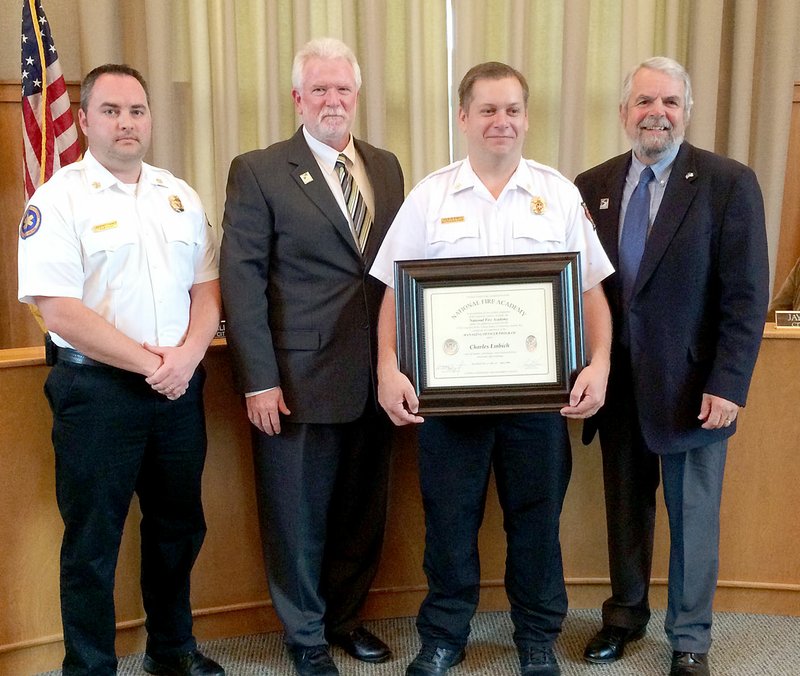Residents are now able to access information about crime in their neighborhoods through the Siloam Springs Police Department's online crime map.
Police Chief Jim Wilmeth and Chris Arrington, an evidence and intelligence technician with the SSPD, presented the new program to city board members on May 15.
The new program collects data about criminal activity in Siloam Springs and other cities. It provides the LexisNexis Community Crime Map, available to the public at commmunitycrimemap.com, which allows citizens to view a map of crimes in their area, sign up to receive email alerts when crimes occur in their neighborhood and submit anonymous tips about crimes directly to the police department. The program also features a secure site with more detailed data available only to police.
Information available to the public will include basic information about the type of crime, block-level address, date and time and a brief narrative. The location of the crime will be offset and specific details will be scrubbed from the data to protect the resident's privacy, Wilmeth said.
Arrington said the information available to the public represents only the "tip of the iceberg" of the new system's capabilities.
The program automatically gathers information from the police department's existing record management system and the computer aided dispatch system, he said. It uses the data to generate descriptive graphics that help users visualize crime patterns and also offers predictive analysis tools. It is also shared and used to collaborate with other agencies.
"One of the things we've been trying to work on for the last three years has been a method of really drilling down into data involving criminal activity, not only in town, but also available to us from other agencies and from other cities," Wilmeth said. "The reason for that is criminal elements tend to move and a lot of times you can gain a lot of information regarding criminal activity, MOs (modus operandi), types of people, their identities, the types of vehicles they drive."
The data will be used to help the police department better support the community and plan their operations. The department has a strategy of being intentional and purposeful of how they patrol the town, he said.
"What we want to stay away from is just the concept of just patrolling and hoping you find something that's going wrong," Wilmeth said. "We want to be purposeful, and looking for that type of activity, and be present in that area in order to interdict it any way we can,"
Wilmeth said he is especially excited about the crime heat map, which is also available to the public. Over a period of time, the heat map can indicate where the strategies are being effective, where they're not, and where criminal activity is moving, he said. The department can see when crime begins to disperse and even when it moves to other cities.
"Naturally it's an intelligence tool, so its value continues to grow, the same way our officers and their experience tends to grow with time," Wilmeth said. "So we had to have a starting point and that affects our overall statistics when we start out, but as we grow, we tend to refine those things down to where we can get even more and more intuitive as to where its headed."
The new system will allow the police department to better partner with the community through transparency by opening up a genuine dialogue between law enforcement and members of the community, Wilmeth said.
"We still don't know neighborhoods the way the people who live in those neighborhoods do, and so being able to talk with them and share their thoughts is very, very useful to us in fighting crime," Wilmeth said.
To use the Community Crime Map, visit communitycrimemap.com and select Siloam Springs, Ark., from the drop down menu. Other Arkansas cities included on the map are Conway, Fayetteville, Fort Smith, Hope, Hot Springs and Tontitown.
In other business, the city board took the following actions:
• Approved a capital budget amendment of $5,547.70 for the addition aquatic matting for the Family Aquatic Center.
• Approved the 2018 surplus declaration of items that will be sold at auction.
• Approved the lease of an airport hanger owned by Matt Shubat to Jonathan Barnett. The city had the right of first refusal to purchase the hangar.
• Approved the third and final reading of Ordinance 18-08 raising water rates in the East Side Rural Water District. Rates will be $27.16 for the first 1,000 gallons, as originally recommended by city staff.
• Approved the second reading of Ordinance 18-09 rezoning 855 S. Wright St. from R-2 (residential medium) to R-3 (residential, two family).
• Approved the second reading of Ordinance 18-10 rezoning 519 S. Hico St. from R-3 (residential, two family) to R-4 (residential, multi-family).
• Approved Resolution 16-18 authorizing the alternate cash flow projection valuation to show the actuarial soundness of the Siloam Springs Fireman's Pension Funds.
General News on 05/23/2018
